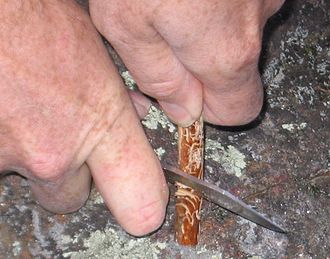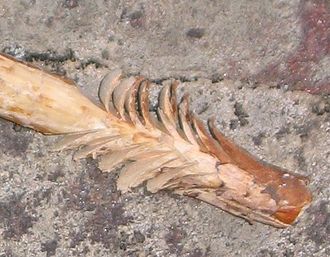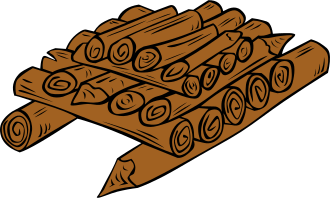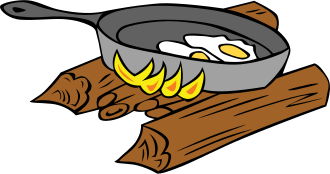Translations:AY Honors/Camping Skills II/Answer Key/60/en
Fuzz sticks
A fuzz stick is a small piece of wood which has had slices cut in the sides to create small shavings. Ideally, the shavings should remain attached to the stick, but if they are accidentally removed, they can still be used. Because the shavings are thin, they are easy to ignite. Because they are attached, they in turn ignite the larger host stick.
To make a fuzz stick safely, choose a piece of dry wood, preferably a dry, dead stick from an evergreen tree. The stick should be about the size of a pencil, or perhaps a little larger. Place one end of the stick against a firm surface, such as a log or a rock, hold the upper end with your left hand, and hold the knife in the right. Carefully slice into the stick with a downward, diagonal motion, maintaining even pressure. Stop before the knife reaches the center of the stick. Take another slice a little higher up, and repeat until the stick is covered with the slices of "fuzz." Turn the stick over and make more shavings on the other side. This is far easier to do with a sharp knife and with a soft wood such a pine, fir, spruce or hemlock. Be sure that you are always slicing away from your fingers. Think at all times about where the knife blade will go if the shaving breaks off, or the knife slips. Make sure that your hand, foot, leg, companions, etc. are not in the path!
Make several fuzz sticks and use them as the first layer of kindling, positioning them atop the tinder. In some cases, the fuzz sticks themselves can be used as tinder.
Council fire
The council fire was used by Native Americans during their meetings (or councils). It is very much like the log cabin fire except that more than two logs are laid on each layer. Be careful not to lay the logs too close to one another. Leave gaps of at least one inch (2.5 cm) between each log to allow air to circulate. Like the log cabin fire, the council fire is very stable, and it falls into itself as it burns, remaining within the fire ring. Unlike the log cabin fire, the council fire lights easily as the main fuel is located directly above the kindling and tinder where convection will carry the flames. This fire is hot and will make a nice bed of coals for cooking. It also uses a lot of fuel. This fire is sometimes called a pyramid fire as well.
Hunter's fire
The hunter's fire is a cooking fire. The logs on top are spaced close enough together such that a pot, pan, or Dutch oven can be placed on them. Try to lay it as level as possible.
Fire safety
- Locate the fire in a safe place. It should be clear for 10 feet (3 meters) all around.
- Do not light a fire beneath overhanging branches or tents, shelters etc.
- Do not use accelerants, such as lighter fluid, gasoline, kerosene, etc. Learn to light a fire without these.
- Put the fire out completely before leaving it. If it's too hot to put your hands in the ashes, it's not sufficiently out. Douse it down with water, turn the coals with a shovel, and be sure to extinguish every coal and ember.
- Do not build a fire on top of flammable material such as grass or leaves.
- Cut away the sod (keep it moist so it stays alive, and replace it before your leave), and clear away the duff and litter.
- Keep fire extinguishing supplies handy and near the fire. A bucket of water or sand, or a fire extinguisher are recommended.
- Do not remove burning sticks from a fire.
- Watch for embers that escape the fire pit and extinguish them immediately.
- Wear proper footwear around a fire.
- Be aware that paper, cardboard, and leaves create floating embers that rise out of the fire pit and may land dozens of yards away.
- Do not light a fire when conditions are adverse (high winds, or drought conditions) or when fires are prohibited by law.




